Dear Chemists: you sniggered and laughed at the disastrous situation of Chinese paper mills in biomedicine. Now watch what Smut Clyde uncovered to be going on in your own field of research, even outside of biomedical nanotechnology aka nanotheranistics. Polymer chemistry, MOFs, ceramics: yes, these have also been fabricated by papermills and placed into your allegedly respectable journals by your allegedly respectable peers acting as editors keen to harness the tremendous application potential. Or maybe these editors are simply on the payroll of piss-taking papermills.
Dear Publisher Executives: I know you are concerned about your business and its credibility. Sure, research fraud is integral part of scholarly publishing, but there are limits, and papermills show them. I expect you as usual to quietly download this multi-paged Google Sheets document Smut Clyde prepared for you, and should you decide to mass-retract those fake organic chemistry papers, feel free to issue editorials crediting yourself and Byrne & Christopher for the discovery. As usual.
Before we begin, we apologise to our readers in the commercially-oriented scholarly publishing industry for Smut Clyde’s trademark irreverential and frivolous writing style unbefitting a serious academic treatise on such complex scientific subject as coordination polymer chemistry. Unlike the research studies he writes about, Smut’s own scribblings haven’t passed peer review, and never will.
Polymer Papermillers taking the piss
By Smut Clyde
“Ceramics” is a broad concept. As well as terracotta tiles and earthenware crockery, it encompasses zeolites, and glasses, and the crystal wizardry of coordination chemistry. So a papermill supplied the Elsevier journal Ceramics International with a series of papers that supposedly explored the possibilities of molecular Meccano, but if the References sections are any guide, they were really more inspired by chickenshit. To be fair, the citations also dwelled on the minutiae of processing corn husks for fuel.

Surrealism and Theatre of the Absurd
Our point of entry is “Atomic layer deposition of Pt nanoparticles on ZrO2 based metal-organic frameworks for increased photocatalytic activity” (Peng et al 2019), whose authors would like us to meet a certain Chao Zhao:
- [15] X. Qiao, C. Zhao, Q. Shao, M. Hassan, Structural characterization of corn stover lignin after hydrogen peroxide presoaking prior to ammonia fiber expansion pretreatment, Energy Fuel. 32 (2018) 6022–6030.
- [16] C. Zhao, X. Qiao, Y. Cao, Q. Shao, Application of hydrogen peroxide presoaking prior to ammonia fiber expansion pretreatment of energy crops, Fuel 205 (2017) 184–191.
- [17] C. Zhao, Y. Cao, Z. Ma, Q. Shao, Optimization of liquid ammonia pretreatment conditions for maximizing sugar release from giant reed (Arundo donax L.), Biomass Bioenergy 98 (2017) 61–69.
- [18] C. Zhao, Z. Ma, Q. Shao, B. Li, J. Ye, H. Peng, Enzymatic hydrolysis and physiochemical characterization of corn leaf after H-AFEX pretreatment, Energy Fuel. 30 (2016) 1154–1161.
- [19] C. Zhao, Q. Shao, B. Li, W. Ding, Comparison of hydrogen peroxide and ammonia pretreatment of corn stover: solid recovery, composition changes, and enzymatic hydrolysis, Energy Fuel. 28 (2014) 6392–6397.
- [21] C. Zhao, Q. Shao, Z. Ma, B. Li, X. Zhao, Physical and chemical characterizations of corn stalk resulting from hydrogen peroxide presoaking prior to ammonia fiber expansion pretreatment, Ind. Crops Prod. 83 (2016) 86–93.
- [22] M. Hassan, M. Umar, W. Ding, E. Mehryar, C. Zhao, Methane enhancement through co-digestion of chicken manure and oxidative cleaved wheat straw: stability performance and kinetic modeling perspectives, Energy 141 (2017) 2314–2320.

And, I hasten to add, this niche concern for the fuel potential of grain-harvest leafy by-products was not limited to the pages of Ceramics International; it manifested in Dose Response, and in Journal of Physics and Chemistry of Solids, and doubtless elsewhere.¹ Perhaps there was an understandable confusion between ‘grass’ and ‘glass’? Were the papermillers taking the piss, or checking whether the journal’s reviewers were paying attention?

* * * SPOILER ALERT * * * No attention was paid.
Here we are back in a familiar domain, dealing with a familiar oeuvre, for this borders on the ‘science-adjacent’ literature of AI and machine learning and fuzzy logic and convolutional neural networks with hidden layers proliferating like epicycles in Ptolemaic cosmology.
We have already encountered this literature where sciency-sounding cargo-cults find a natural home, and where one or more papermills studios offer a broad range of services and products, characterised by certain distinctive attributes. All creating an oeuvre marked by preposterous titles and references that pay homage to Surrealism and Theatre of the Absurd. Like the tail of a scorpion, the Reference sections of these papers are the part that focus one’s attention.
Coordination Polymer Papermills
That is a lot of words, so it is time for the repeated images. How about some versatile Scanning Electron Microscopy?
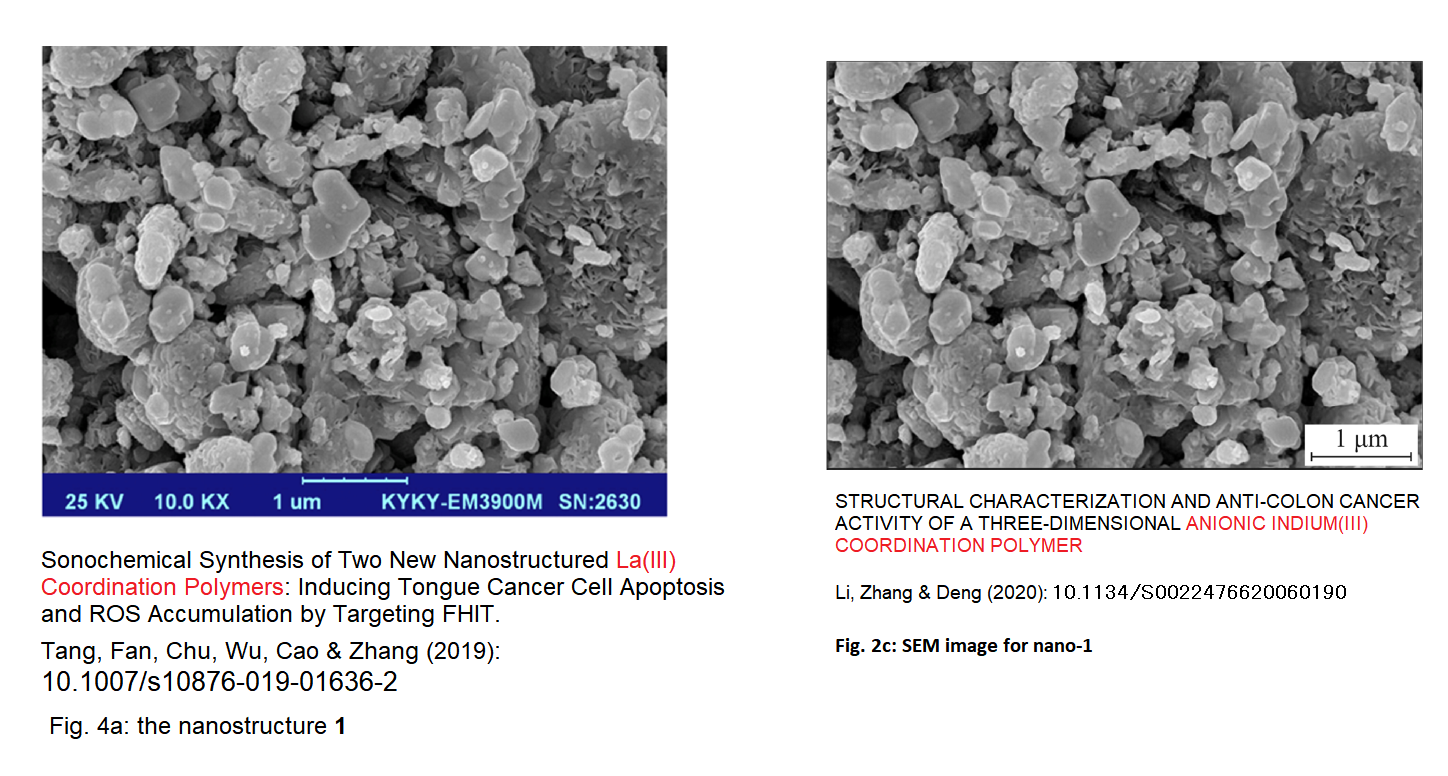
[left] Fig 4a from “Sonochemical Synthesis of Two New Nanostructured La(III) Coordination Polymers: Inducing Tongue Cancer Cell Apoptosis and ROS Accumulation by Targeting FHIT” (Tang et al 2019). [right] Fig 2c from “Structural Characterization and Anti-Colon Cancer Activity of a Three-Dimensional Anionic Indium(III) Coordination Polymer” (Li, Zhang & Deng 2020).
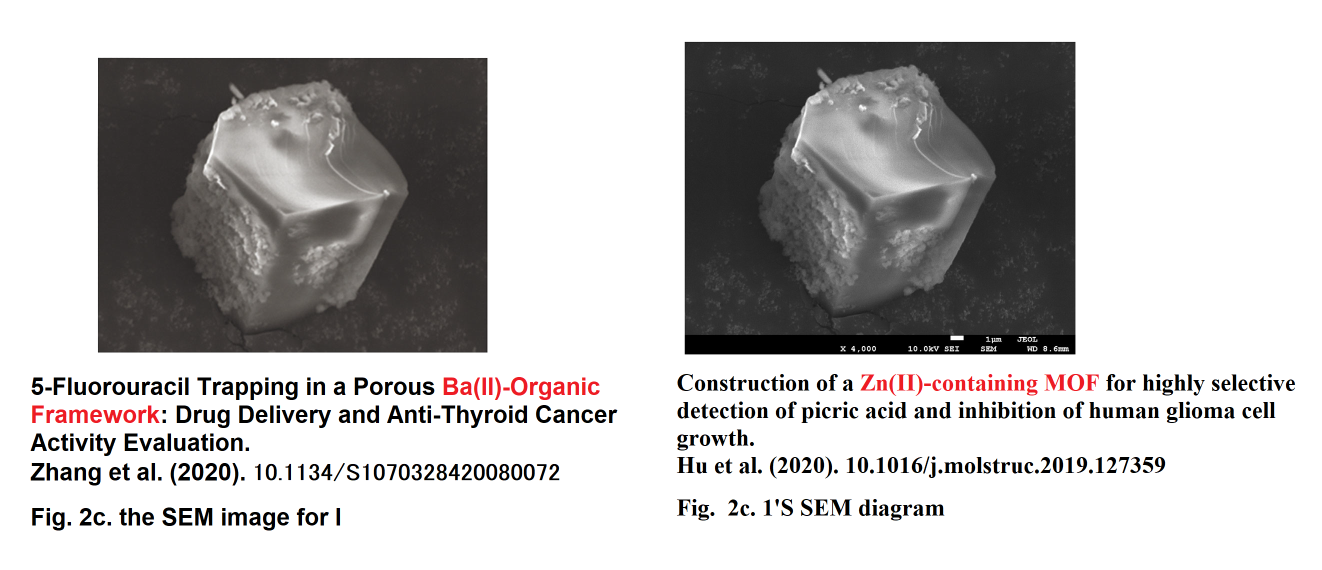
Fig 2c from “5-Fluorouracil Trapping in a Porous Ba(II)-organic Framework: Drug Delivery and Anti-thyroid Cancer Activity Evaluation” (Zhang et al 2020)… Fig 2c from “Construction of a Zn(II)-containing MOF for highly selective detection of picric acid and inhibition of human glioma cell growth” (Hu et al 2020)… and Fig 3c from “A new Ca(II) coordination polymer for effective 5-fluorouracil loading and inhibiting human retinoblastoma cells” (Liu, Shen & Song 2019).
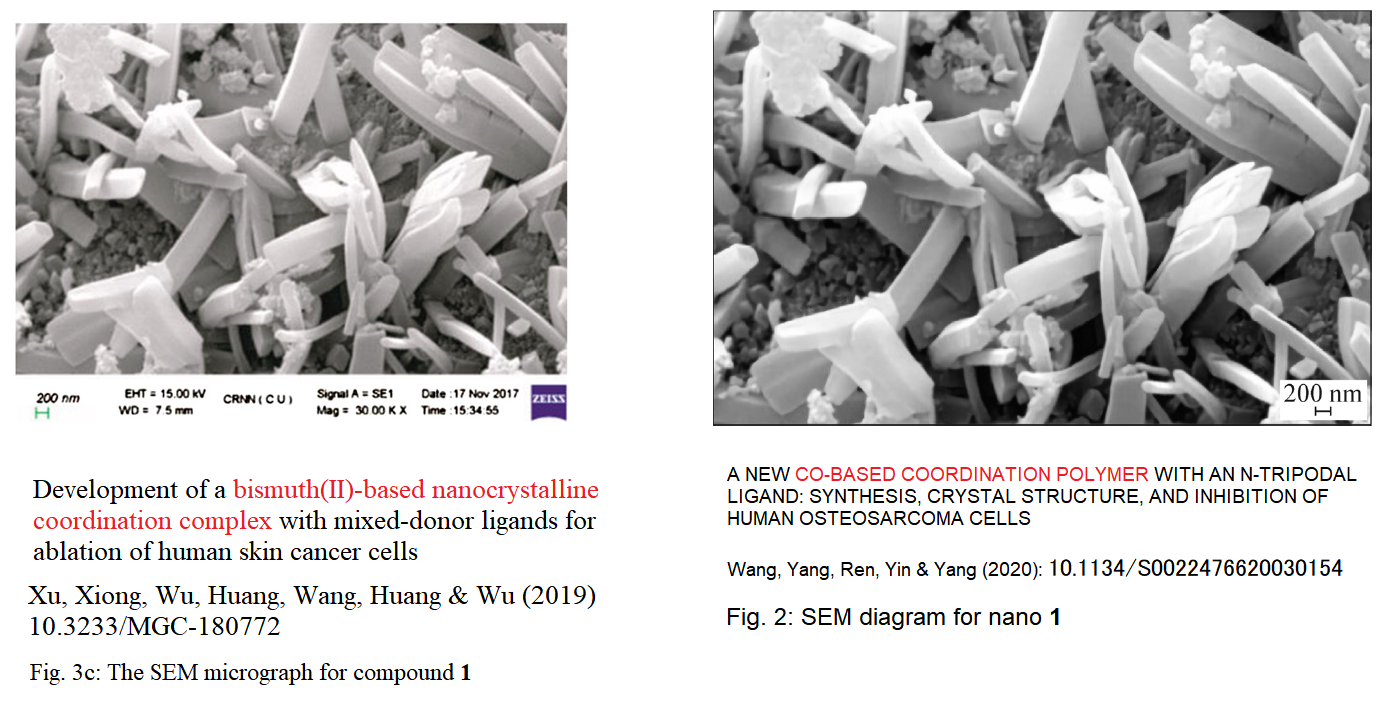
[left] Fig 3c from “Development of a bismuth(II)-based nanocrystalline coordination complex with mixed-donor ligands for ablation of human skin cancer cells” (Xu et al 2019). [right] Fig 2 from “A New Co-Based Coordination Polymer with an N-Tripodal Ligand: Synthesis, Crystal Structure, and Inhibition of Human Osteosarcoma Cells” (Wang et al 2020).

[left] Fig 4c from “Two Cu(II) coordination polymers based on benzene-1,3,5-tricarboxylate and 1,2,4-triazolide ligands: their crystal structures and application of nanoparticles in anti-esophageal cancer activity evaluation” (Zhu et al 2019). [right] Fig 3B from “A new Pb(II)-based coordination polymer constructed by 5-((4-carboxyphenoxy)methyl)benzene-1,3-dioic acid and N-donor co-ligand: crystal structure and anti-glioma activity” (Wang et al 2019).

[left] Fig 3b from “Crystal Structures and Inhibiting Human Cardiac Myoma Cells Activity of Co(II) and Cu(II)-based Coordination Polymers Constructed from 4-(1H-pyrazole-4-yl)benzoic Acid and 4,4′-Bipyridine Ligands” (Zheng et al 2019). [right] Fig 5b from “Two New Eu(III)-Based Coordination Polymer Nanoparticles Constructed from the V-Shaped Carboxylic Linkers: Synthesis, Crystal Structures and Anti-oral Cancer Studies” (Zhang & Zhao 2018).
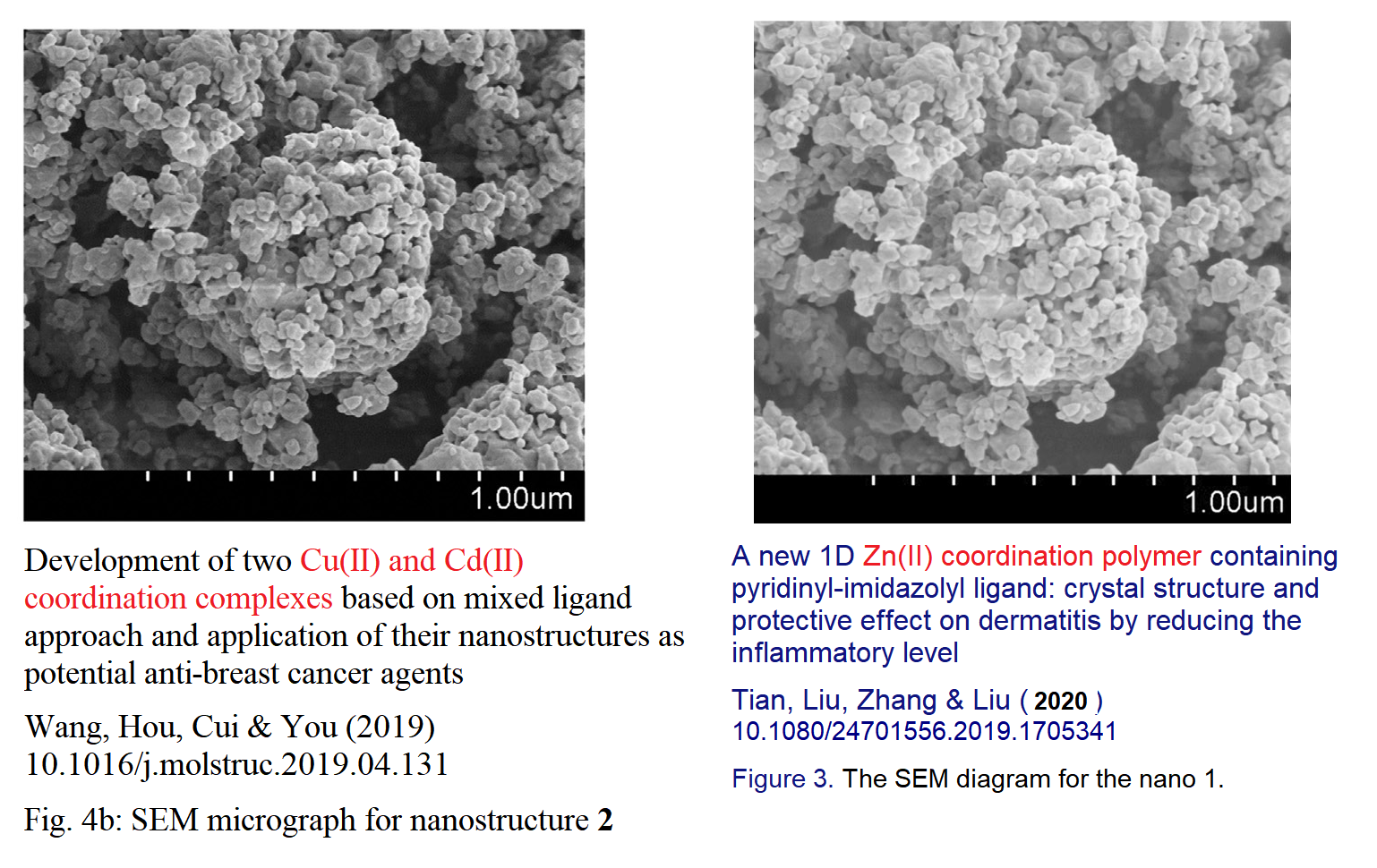
[left] Fig 4b from “Development of two Cu(II) and Cd(II) coordination complexes based on mixed-ligand approach and application of their nanostructures as potential anti-breast cancer agents” (Wang et al 2019). [right] Fig 3 from “A new 1D Zn(II) coordination polymer containing pyridinyl-imidazolyl ligand: crystal structure and protective effect on dermatitis by reducing the inflammatory level” (Tian et al 2020).

[left] Fig 2c from “Indium(III)-coordination polymer based on a C3-symmetric ligand: crystal structure and anticancer activity on neuroblastoma” (Deng et al 2020). [right] Fig 3c/d from “1D/3D Co(II)-based coordination polymers: protective effect on alzheimer’s disease by inhibiting neurons apoptosis and Aβ accumulation” (Zhang 2021).

[left] Fig 2 from “A new Ni(II)-based coordination complex: crystal structure and anti-biofilm activity against P. gingivalis during periodontal diseases” (Shu et al 2020). [right] Fig 4 from “Two Coordination Polymers Containing 4,4′-Di(1H-Benzo[D]Imidazol-1-yl)Biphenyl Ligand: Crystal Structures and Anticancer Activity on Human Multiple Myeloma Cells” (Guo et al 2020)(Retracted) and Fig 3 from “TWO NEW Co(II)-BASED COORDINATION POLYMERS:CRYSTAL STRUCTURES AND THE LOCAL ANALGESIA ACTIVITY DUE TO REDUCING LOCAL ACETYLCHOLINE CONTENTS” (Liu & Li 2020).
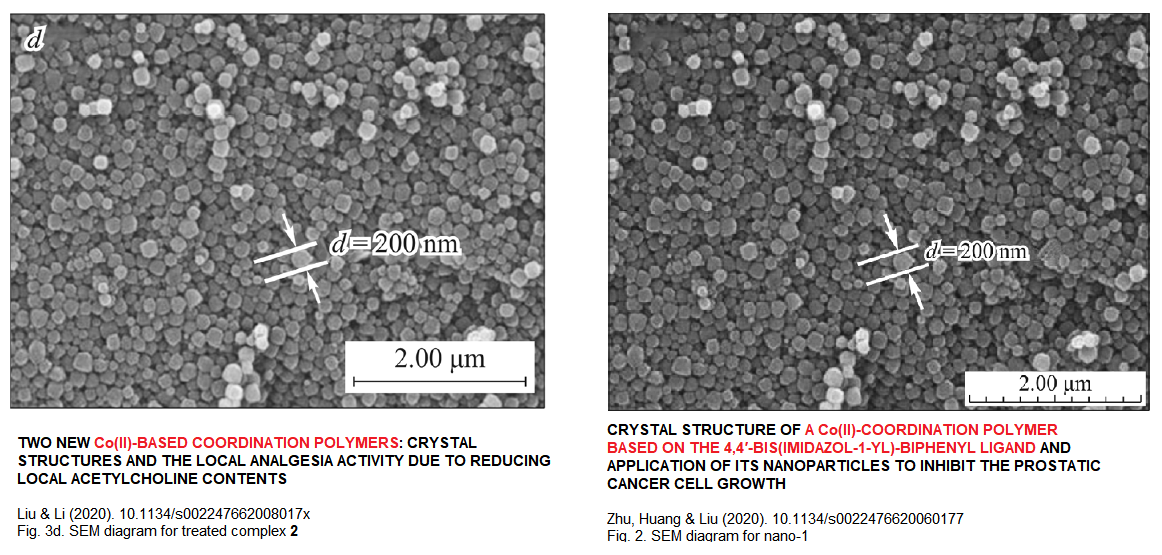
[left] Fig 3d from Liu & Li (2020). [right] Fig 2 from “Crystal Structure of a Co(II)-Coordination Polymer Based on the 4,4′-Bis(Imidazol-1-YL)-Biphenyl Ligand and Application of its Nanoparticles to Inhibit the Prostatic Cancer Cell Growth” (Zhu, Huang & Liu 2020).
[Many hat-tips to Sylvain Bernès]
MOF papermills
But now for something completely different (which is to say, something almost entirely the same), here is a second strip of References Wallpaper.
- Guo S, Chen R, Li H, Zhang T, Liu Y (2019) Int J Softw Eng Knowl 29:139 “Identify Severity Bug Report with Distribution Imbalance by CR-SMOTE and ELM”
- S. Guo, R. Chen, M. Wei, H. Li, Y. Liu, IEEE Access 6, 45934–45950 (2018) “Ensemble Data Reduction Techniques and Multi-RSMOTE via Fuzzy Integral for Bug Report Classification”
- L. Kang, L. Zhao, S. Yao, and C. Duan (2019). Ceram. Int.45, 16717. “A new architecture of super-hydrophilic β-SiAlON/graphene oxide ceramic membrane for enhanced anti-fouling and separation of water/oil emulsion”
- H. Li, G. Gao, R. Chen, X. Ge, S. Guo, and L. Y. Hao (2019). Int. J. Softw. Eng. Know. 29, 93. “The Influence Ranking for Testers in Bug Tracking Systems”
- Su J, Sheng Z, Xie L, Li G, Liu AX (2019) IEEE Trans Commun 67:2527 “Fast splitting based tag identification algorithm for anti-collision in UHF RFID system”
- J. Su, Z. Sheng, V.C.M. Leung, Y. Chen, IEEE Wirel. Commun. 26, 118–124 (2019) “Energy Efficient Tag Identification Algorithms For RFID: Survey, Motivation And New Design”
- Zhang D, Zhang HQ, Zhao S, Li ZG, Hou SX (2019) Int J Electrochem Sci 14:4659 “Electrochemical Impedance Spectroscopy Evaluation of Corrosion Protection of X65 Carbon Steel by Halloysite Nanotube-Filled Epoxy Composite Coatings in 3.5% NaCl Solution”
Citations are recycled across dozens of products from the papermill, with no regard for their relevance to the topic, ‘relevance’ not being a priority of the journal editors or reviewers (let alone the putative authors). We have already met Guo et al (2020)(Retracted).

Apart from an outlier involving exotic anti-corrosion nano-coatings, the focus of this second nexus or nidus of references is more about software and RFID tags, which somehow came to illustrate the medicinal properties of a succession of Metal-Organic Frameworks (MOFs).

MOFs are an active arena of research now. These are not androids or Giger-esque bio-mechanical constructs. I am not the right person to explain how Metal-Organic Frameworks are distinguished from Coordination Polymers (CPs), for there are tribal groups in what remains of the Amazonian Rainforest who know more about this stuff than me. I imagine them all as higher-order crystals, in which the building-blocks are organic molecules (ligands), ligated by bonds to polyvalent metal ions bolting them together at the corners, assembled in a kind of molecular Meccano.
[here some MOFs in Science, by Nobel prize winner Sir Fraser Stoddart, -LS]
The papers are assembled in analogous fashion, from pre-formed modules and sub-units… or perhaps the manuscript just crystallise spontaneously out of solution when the conditions are right, and submit themselves to suitable journals of flexible, negotiable standards of peer-review. The References modules are not tailored to harmonise with the Introduction or Methods or Results modules so any resemblance to the in-text citations is purely coincidental.
 The popularity of the topic created a motivation for equally ill-informed academics to become active participants, despite being graduates of the Zoolander Center for Kids Who Can’t Research Good and Who Wanna Learn to Do Other Stuff Good Too. It also means that papermills sprang up to facilitate their ambitions … or at any rate, an existing papermill diversified.
The popularity of the topic created a motivation for equally ill-informed academics to become active participants, despite being graduates of the Zoolander Center for Kids Who Can’t Research Good and Who Wanna Learn to Do Other Stuff Good Too. It also means that papermills sprang up to facilitate their ambitions … or at any rate, an existing papermill diversified.
There are so far over 400 Pubpeer threads on the resulting paper-shaped assemblages, most of them from 2019/2020 (2021 has hardly been touched) — there is really no end in sight. One can only guess at the scale of this train-wreck. I have helpfully tabulated the train-wreck in a spreadsheet (more precisely, a worksheet within an existing spreadsheet).
In a different crystallography-papermill context, Sylvain Bernès pointed out that the modular nature of the compositions enables titles and subjects to be generated combinatorially, as if inspired by Queneau’s “A Hundred Thousand Billion Poems” aleatoric sonnet generator. This is the kind of highbrow erudition we expect at Pubpeer.
This is just usual business with predatory journals. The same powder pattern might show up anywhere with any random formula, like U1.2K1.8S2.1N4O2.8Te2.
Vous vous souvenez de “Cent mille milliards de poèmes“, le bouquin très oulipien de Raymond Queneau ? Ben là c’est pareil : prenez 10 formules, 10 patrons de diffraction et 10 spectres de n’importe quoi, et vous avez 1000 articles.
Je pense m’y mettre prochainement, il semble que ça soit plus rentable que d’essayer de faire de la recherche.
Mostly the confections target what I like to think are write-only journals, designed to be cite-mined but never actually read. Elsevier have the Journal of Molecular Structure. Taylor & Francis have the Journal of Coordination Chemistry and Inorganic and Nano-Metal Chemistry. IOS, Main Group Chemistry. Springer are doing particularly well with Journal of Structural Chemistry, Journal of Cluster Science, Journal of Inorganic and Organometallic Polymers and Materials, and I could go on — these are not fringe publishers.
The scale of mass-production would be more alarming if there were any danger of those 400+ papers having readers and influence. The topic is also one where the depth of my ignorance is loosely comparable to the Marianas Trench, but perhaps some more knowledgeable readers can weigh in on the calibre and impact of these journals.
Any institutional library forced to subscribe to one of these journal-shaped garbage scows (as part of a subscription bundle) has been swindled. Over 90% of the contents of an issue might reveal a papermill provenance. It can’t have been easy for the editors and reviewers to keep themselves blinded to the relentless barrage of recycled components. One can imagine that publishers might be concerned for their reputations, and motivated to replace the journals’ editors and standards, but even so it is hard to see how they can be salvaged.
Floor Wax & Dessert Topping

One curious aspect of all this is that the millers’ ambitions outgrew the narrow confines of a single application for each newly-invented MOF. It was not enough to sieve one gas from another, through the pore size of the atomic architecture, or to fluoresce when detecting a pollutant; the fantasy materials also have to be anaesthetics, or cures for cancer (or tuberculosis or psychosis or Chronic Obstructive Pulmonary Disease). The resulting titles are reminiscent of Shimmer, which was (as any fule kno) a floor-wax and a dessert topping.
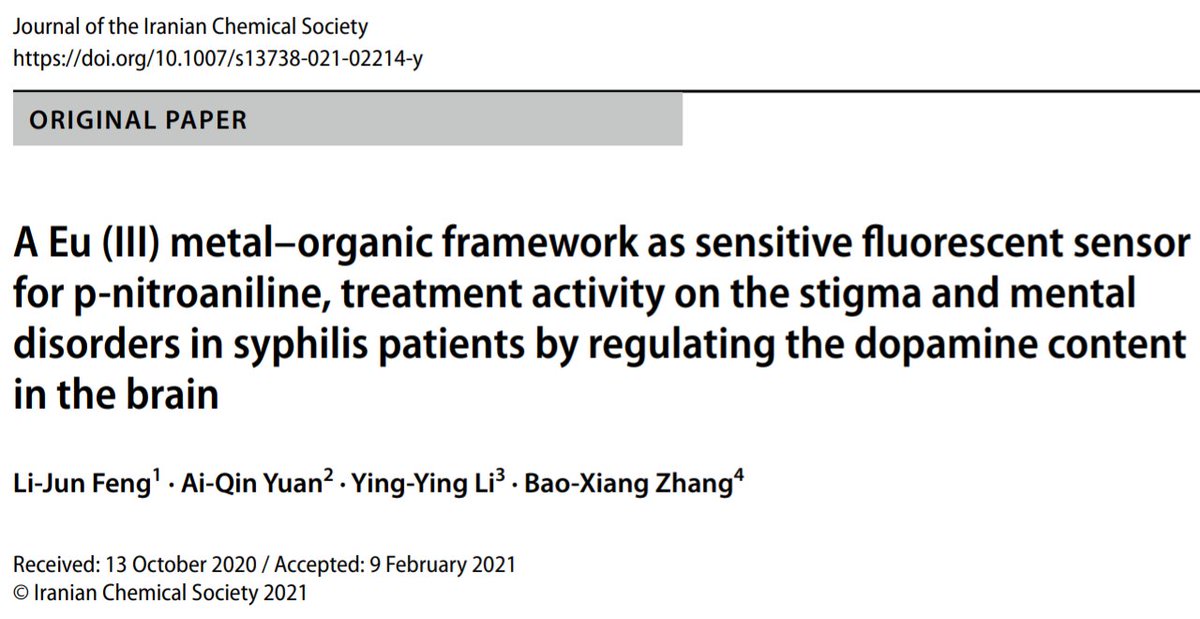
- A ketone-functionalized Zn-MOF for solvent-free cyanosilylation of aldehyde and treatment activity against osteosarcoma through increasing Mg63 cells autophagy!
- A porous Co(II)–MOF for selective C2H2/CO2 separation and treatment activity on virus-induced COPD via reducing tlr3 gene expression!
- A water-stable Eu(iii)-MOF for phosphorescent detection of acetone and treatment effect on catheter-associated infections by inhibiting gram positive and negative bacteria survival!
- A Dy(iii)–organic framework as a fluorescent probe for highly selective detection of picric acid and treatment activity on human lung cancer cells!
- Two Co(II)-based coordination polymers: photocatalytic dye degradation properties and treatment effect against colon cancer by inhibiting IL-6-STAT3 inflammatory signaling pathway!
All this requires animal models, where laboratory rats or mice have (supposedly) been mutilated and tortured to mimic the medical condition du jour; or equally imaginary in-vitro experiments on vat-grown cell-lines. These both require forms of bafflegab and jibber-jabber in which the papermillers are not fluent, forcing them outside their comfort zone. So the absurdities proliferate like cancer cells in a culture medium… we find uterine fibroids (leiomyomata) described as a form of cancer, and retinoblastoma cell-lines presented as an in-vitro model of uveitis. In the manner of a dream, “intraarterial cells” morph into “periodontal mucosal cells”, as if a faked piece on periodontitis had been hastily and incompletely repurposed as atherosclerosis for a different customer.
- “Two coordination polymers: selective detection of TNP and treatment activity on uterine fibroids combined with ultrasound treatment via inducing cancer cell apoptosis” (Ni et al 2021)
- “A fluorescent Zn(II)-based complex for the selective detection of PA and treatment effect on uveitis by reducing the inflammatory response and inflammatory cytokine release” (Chen, Liu & Zhang 2021)
- “Two Zn(II) carboxylate-terpyridine coordination compounds: crystal structures and biological activity” (Xuan et al 2020)
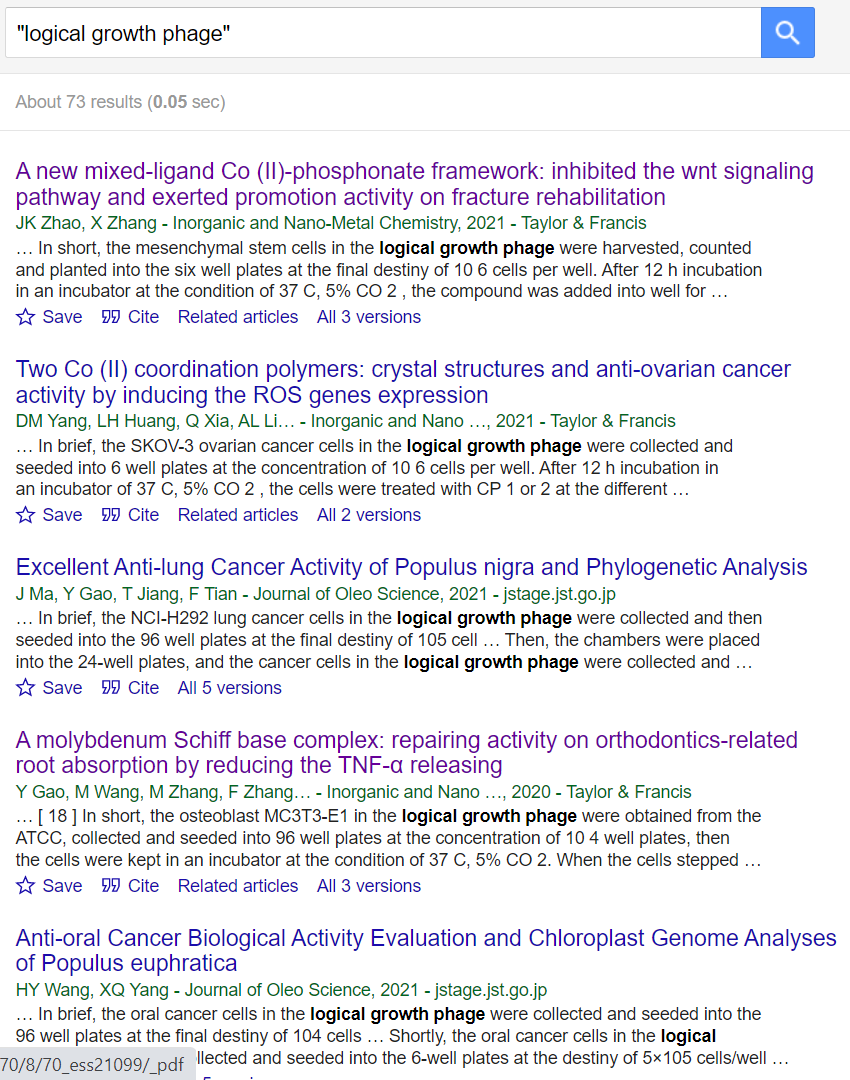 We repeatedly encounter an intriguing, previously-unknown “logical growth phage“. Perhaps a synthetic variety of bactericidal virus?
We repeatedly encounter an intriguing, previously-unknown “logical growth phage“. Perhaps a synthetic variety of bactericidal virus?
Fortunately the editors and the hypothetical peer-reviewers are equally unwise in the ways of biologists, for the journals in question lean towards chemistry and material engineering (see how I lean over backwards to be fair?). Thus they overlook the absences and the blunders that would anguish real biologists. Maybe they simply don’t see the absurdity of Methods Sections where the authors claim to have multiplied neurons or cochlear hair cells in a Petri dish, or to have infected mice with Hepatitis-B Virus, or to house mice “cultured in the standard condition of 37 °C, 5% CO2“.
- “Two New Zn(II)/Cu(II) Compounds: Photoluminescent and Photocatalytic Properties, and Protective Activity on Parkinson Disease” (Wang et al 2021)
- “A porous Er(III)–organic framework as a highly efficient catalyst for chemical fixation of CO2 and treatment activity on senile deafness via inducing the cochlear hair cell apoptosis” (Sun et al 2021)
- “Construction of a new luminescent Cd(ii) compound for the detection of Fe3+ and treatment of Hepatitis B” (Huang & Xu 2021)
- “Zn(II) and Co(II)-based coordination polymers: anesthesia effect by regulating animal blood pressure in hip replacement operation” (Bao et al 2021)
- “Two Zn(II) Coordination Polymers: Luminescent Sensing Property and Treatment Activity on Uterine Leiomyomas by Reducing TGF-β Releasing and mmp-3 and mmp-7 Expression” (Li et al 2021)
- “3D Cu(II) Cluster-Based Coordination Polymer: Increasing the Activity of Prothrombin and Preventing Postpartum Hemorrhage” (Pan et al 2021)
It is unreasonable to expect them to notice that the species of animal in an in-vivo fantasy alternated between “mouse” and “rabbit”… both have four legs after all, so from a physics perspective they are interchangeable. Rats and mice are even more easily confused. It is like expecting normal people to know that rodents can’t vomit, or that porcupines are allergic to raisins.
I am not making this up.
Eccentric exercise and striking


Am I alone in wondering about the Method of “eccentric exercise and striking” inflicted on 40 BALB/c mice for 8 weeks, to drive them into Myofascial Pain Syndrome? The authors forgot to explain it. To be honest it sounds like normal conditions at an English public school.
- “Two mixed-ligand coordination polymers: Magnetic properties and biological evaluation on myofascial pain syndrome by reducing IL-6 release” (Liu et al 2021)²

- “Two Zn(II)-based coordination polymers: treatment effect on the cardiac arrest induced by anesthesia by regulating Sirt1 expression” (Chen et al 2020)
- “Two Co(II) coordination polymers: application values on spinal osteomyelitis by reducing the inflammatory response in the paravertebral soft tissue” (Fu et al 2021)
- “Two Zn(II)-based Coordination Polymers: Fe3+ Ion and Prevention Activity Detection On Postpartum Hemorrhage By Regulating Anticoagulant Factor Activity” (Wu et al 2020)
Another detail consistently absent across this entire corpus of garbage studies is how the materials were administered to the fictitious lab-rats or Petri dishes [H/t Ceylonthelphusa cavatrix]. The whole point of these MOFs and CPs is that the ligands and their coordinating metal ions have crystallised out of solution, under unique conditions of heat and pressure. It makes no sense to dissolve them again and inject them for their ostensible medical applications; a soup of Meccano components and heavy-metal toxins is injectable, but it’s not a MOF any more. Were they inhaled? Waved over the cages to cast a shadow? Fed to the animals? Stuck to their backs with a strip of adhesive tape? The reviewers don’t care.
I suppose the insoluble crystals could be injected as a finely-pulverised suspension, mortar-and-pestled to the edge of oblivion. There we enter the realms of Renaissance quacksalvery, where the ingredients of a sovereign remedy for Ague or Dropsy or a surfeit of assassins might include ‘powdered chalcedony’.
Yet another clue to the fabulated nature of these experiments is the absence of rodent mortality. In consensus-reality research you might begin with four groups of 15 rats each, but two months later the numbers per group might range from 11 to 16, some of them having died from ennui and the trauma of botched surgery, or burst spontaneously into flame, or teleported from one cage to another. This is just what lab rats do, out of sheer perversity, and it seems churlish to deny them a few simple forms of entertainment.
Seventy-Flavor Pearl Pills
Perhaps it is time for another pictorial interlude. These are TEMs, Transmission Electron Microscopy, but after misidentifying them as SEMs, the papermills repeat the error every time they recycle the images.
[left] Fig 3 from “Crystal Structures and Anti-Gastric Cancer Activities of Two Cd(II)-Based Coordination Polymers Constructed from Different Donor Ligands” (Zheng & Yang 2020); [right] Fig 4c from “Two novel nanostructured La(III) coordination polymers were synthesized by sonochemical: crystal structures along with anticancer activity on human nasopharyngeal carcinoma cells” (Cui et al 2020)
[left] Supplementary Fig S5 from “Two Co(II)-based coordination polymers: structural diversity and treatment effect on the cardiac arrest induced by anesthesia by regulating Sirt1 expression” (Jiang et al 2020); [right] Figs 2c from “A Co(II)-based coordination polymer: inhibitory activity on cervical cancer cells” (Chen et al 2021) and 2c from “Structural Characterization, Molecular Docking and Protective Effect on Coronary Artery Disease of a New Nanostructured Cu(II)-Coordination Polymer by Reducing the Inflammatory Level” (Liu et al 2020).

Don’t ask what goes into “Seventy-Flavor Pearl Pills” that reduces monoamine neurotransmitter activity (serotonin & dopamine), thereby minimising the damage caused by cerebral ischemia in an animal model. Regrettably, the authors never describe the magic beans. The mystery continues into “Two Yb(III) coordination polymers: treatment effect with seventy-flavor pearl pills on cerebral ischemia by reducing the content of monoamine neurotransmitters” (Zhao, Wang & Sun 2020): we learn nothing about the constituents of the pearl pills, the dosage, not even their supplier.
Thermal gravimetric analysis (TGA) characterises a MOF by plotting the temperature required to drive out the volatile molecules sequestered within their pores. I have no idea how TGAs are acquired, or whether it is reasonable for them to backtrack and either acquire weight or lose temperature. I am reasonably confident, though, that they should not be identical (modulo displacements along the temperature or weight axes) for a variety of these exotic substances.
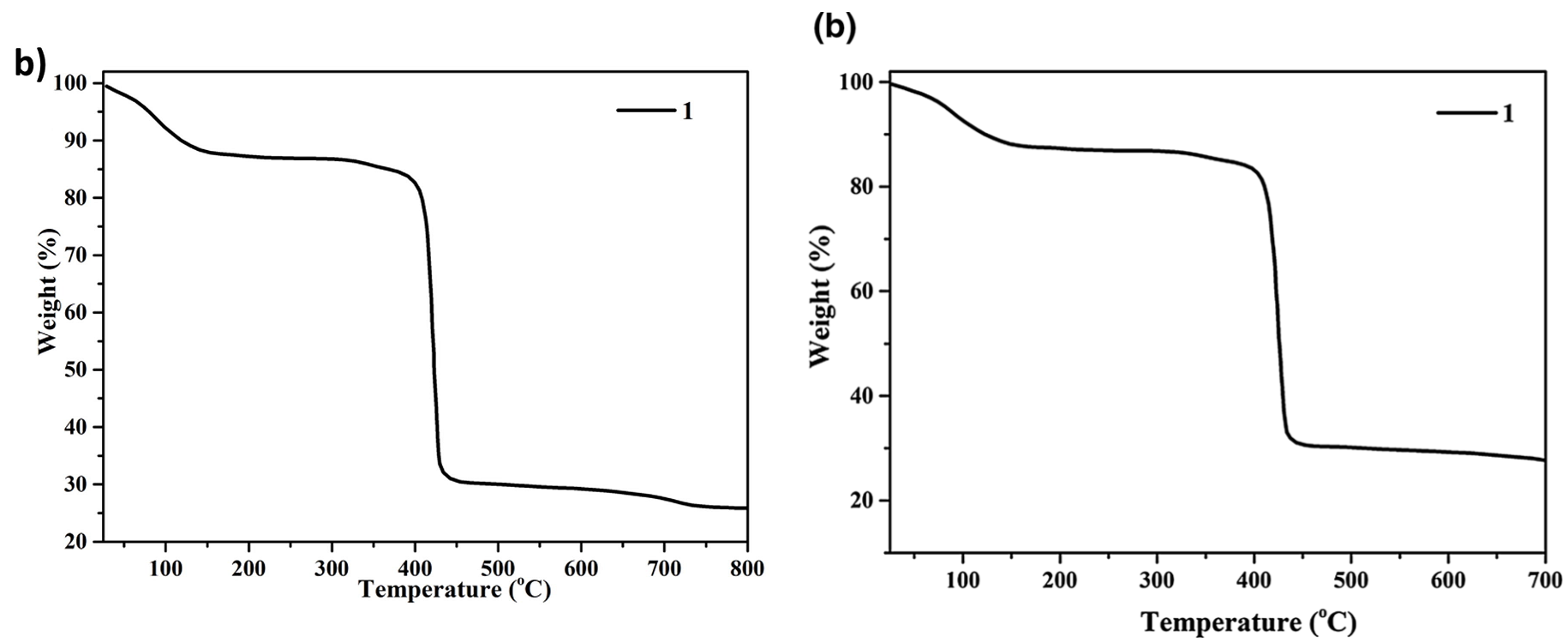

Other manifestations include Fig 2b from Hou et al (2020b) Fig 3b from Wang et al (2019); Fig 2b from Deng et al (2020); Fig 2b from Cao et al (2020); Fig 2b from Liu et al (2021). After that I stopped looking.
- “Two/zero-dimensional Cu(II) complexes inhibit atrial myxoma cells via apoptosis” (Tian et al 2019)
- “A Heterometallic MOF for Highly Selective Al3+ Ion Detection and Protective Effect Against Periodontitis by Reducing P. gingivalis CFU and Inflammatory Cytokines Levels” (Hou et al 2020b)
- “Development of two Cu(II) and Cd(II) coordination complexes based on mixed-ligand approach and application of their nanostructures as potential anti-breast cancer agents” (Wang et al 2019)
- “Indium(III)-coordination polymer based on a C3-symmetric ligand: crystal structure and anticancer activity on neuroblastoma” (Deng et al 2020)
- “A new porous cationic metal–organic framework: selective sorption of organic dyes and treatment on neural stem cells during spinal cord injury treatment” (Cao et al 2020)
- “A Cu(II) complex: treatment activity on intracerebral hemorrhage via inhibiting inflammatory response in vascular endothelial cells” (Liu et al 2021)
Good old FTIR
These are FTIR spectrographs. They turn out to be almost as versatile as the scanning electron microscopy.
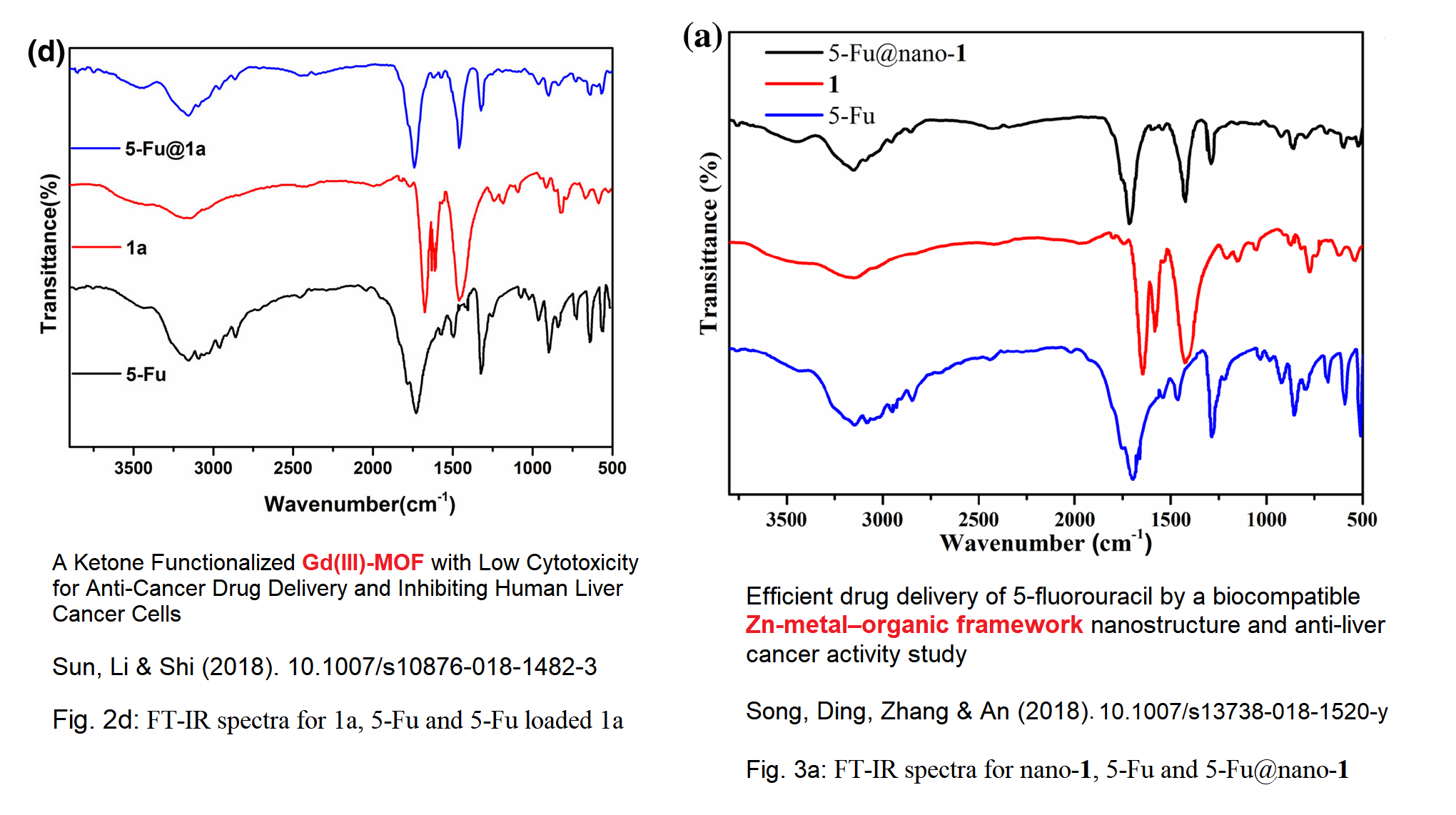
[left] Fig 2d from “A Ketone Functionalized Gd(III)-MOF with Low Cytotoxicity for Anti-Cancer Drug Delivery and Inhibiting Human Liver Cancer Cells” (Sun, Li & Shi 2018); [right] Fig 3a from “Efficient drug delivery of 5-fluorouracil by a biocompatible Zn-metal–organic framework nanostructure and anti-liver cancer activity study” (Song et al 2018).

[left] Fig 4d of “A water stable metal–organic framework with 1D nanotube pores for 5-fluorouracil delivery and anti-brain tumor activity” (Lv, ZHao & Zhao 2019); [right] Fig 3b of “A microporous Co(II)-MOF as a pH-responsive 5-Fu delivery system to induce human hemangioma cells apoptosis and abrogate their growth” (Wang et al 2020).
H/t to Sylvain Bernès, who does know all about this area of research, and who is not well-pleased to have it besmirched by papermill mass-production and shenanigans.
[left] Fig 3C from “Co(II) and Cu(II) coordination polymers: Crystal structures and treatment effect on acute lung injury treatment by inhibiting inflammatory response” (Li & Yan 2020); [right] Supplementary Fig S1 from “Two Zn(II) carboxylate-terpyridine coordination compounds: crystal structures and biological activity” (Xuan et al 2020).
I could go on, but common sense prevailed, so Fig S1 from Tang et al (2020), Fig 3 from Ma, Han & Mei (2021), Fig 3 from Sun et al (2021), and Fig 3 from Fang et al (2020) are left as an exercise for the reader.
- “Cu(II) coordination polymer: treatment effect on catheter-associated urinary tract infectious via suppressing Staphylococcus aureus growth in vitro and in vivo” (Tang et al 2020)
- “2D/3D coordination polymers: treatment effect on the ulcerative colitis by reducing the inflammatory response” (Ma, Han & Mei 2021)
- “Synthesis and crystal structure of two new Zn(II) and Ni(II) coordination polymers with anti-ovarian cancer activity” (Sun et al 2021)
- “Two Mixed-ligand Coordination Polymers: Crystal Structures and Protective Effect on Ischemic Stroke by Increasing glp1r Expression” (Fang et al 2020)
But I cannot resist comparing Figs 2B from Shu et al (2018), and 2c from Song et al (2019).
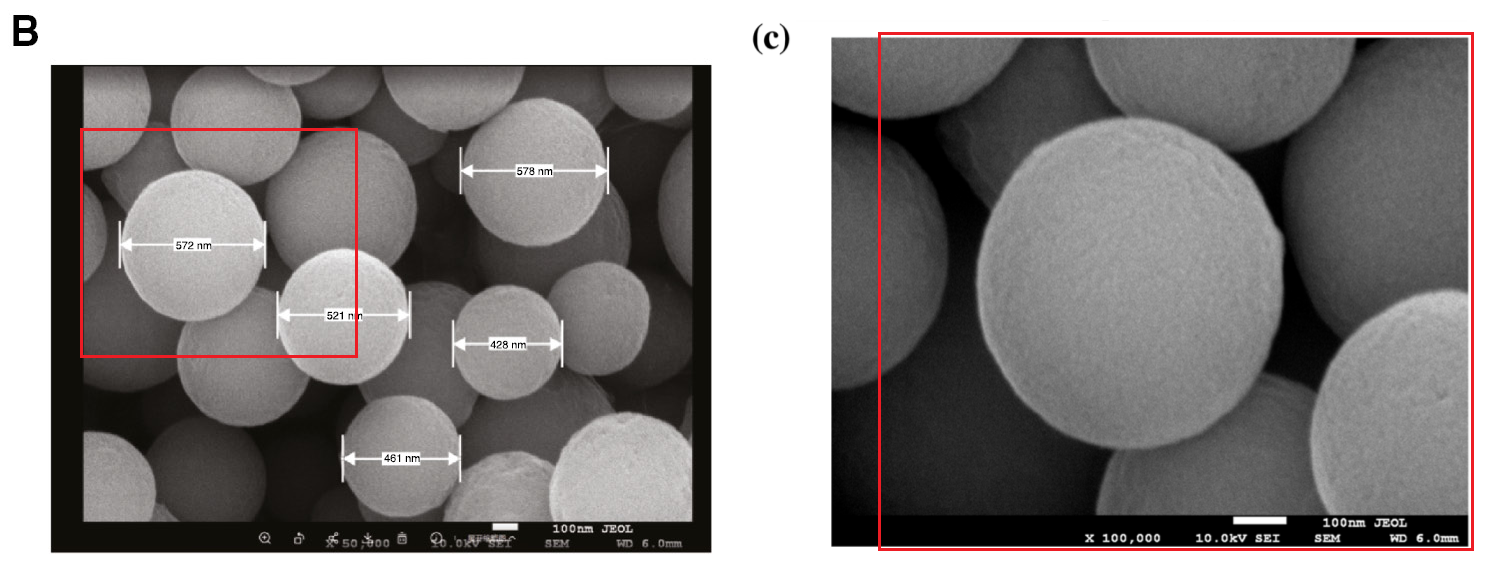
To finish an earlier theme: Suppose authors specify “hyperthermia” or “intense ultrasonic” in the Title and Abstract, as part of a cancer cure (that is, as part of a way to kill cancer cells in vitro), but in the text of the paper they forget all about that aspect of the treatment. Setting aside my earlier attempts at fairness, and my efforts to blame everything on their chemistry or engineering mindset: Is it understandable for reviewers not to notice?³ When editors hone their rubber-stamping skills and allow a papermill’s products to engulf entire issues, studiously oblivious to the glaring evidence of common authorship, they are working for the papermill whether or not they are paid for it.
- “Protective Capability of Cu(II) Complex Delivered by Ultrasonic Intervention on Deep Venous Thrombosis” (Shi et al 2021)
- “Two metal-coordination polymers: Photocatalytic hydrogen production and clinical nursing value on gastric cancer combined with hyperthermic intraperitoneal chemotherapy by inducing induce oxidative stress response” (Liu, Chen & Li 2021)
Logical growth phage
Now let’s go back to that “logical growth phage” (or sometimes “phage of logical growth“). “Preformation” — mistaken for a synonym of “procedure” or “performance” — is another distinctive verbal flourish with which the papermillers sign their work. They are also fond of “ultimate destiny“, a term with alarming connotations which usually end with an invasion of Poland.
However, the main hallmark of the mill — holding everything together in the manner of the Dude’s Persian rug — is their practice of cobbling Reference sections together from recycled strips, like wallpaper cut to the desired length. They plug items from the strip randomly into the “Citation-goes-here” slots within the modules of text, regardless of the relevance of each reference to its context. Most of the strip are at least vaguely relevant to the topic of CPs and MOFs, but the incongruous juxtapositions are not helped by outré, recherché references (the ones invoking composting techniques or RFID algorithms) as if challenging reviewers to object.
If one were inclined to divide the papermill’s output into distinct phases, on the basis of stylistic cues, the phase I described up at the beginning (with its leaf-to-fuel and chickenshit References) is an intermediate one. Earlier came a series of 2018 papers, where the surreal juxtapositions were provided by a “bullshit quartet” of Bovine Digestive Dysfunction papers: see Song et al (2018) for a list. The same References were prevalent in a series of contemporaneous papers, on more obviously bullshit-friendly topics but equally papermilled, which is why I incline to see the same studio at work. In the present context they were joined by “Inflammatory mechanism of Rumenitis in dairy cows with subacute ruminal acidosis“, because the literature on bovine dyspepsia is more extensive than I realised; also papers on “the ceramide pathway” and “Neuropeptide Y“.
- “A Porous Zn2(abct) Framework as an Efficient Carrier for 5-Fu Delivery and Inhibiting Human Liver Cancer Cells” (Song et al 2018)
In another intermediate phase, a single composting paper sufficed, while the concepts of ‘MOF’ and ‘Coordination Polymer’ broadened to encompass inorganic ceramics, fire retardants, soil detoxification, ZnO anticorrosion coatings, and information-tracing abstractions from the Internet of Things. Some RFID algorithms persisted in this phase – perhaps as a tribute to IEEE journals, as from the perspective of research integrity, you will never find a more wretched hive of scum and villainy than the IEEE.
The point I am struggling to make is that these repeating, stereotyped constellations of co-occurring References evolve: the papermillers upgrade their EndNotes file, replacing items after a few months. But as if under a geas, they like to have a few outré items to maximise the incongruity.
All this invites the question, where do these weird citations come from? Perhaps there is a transactional aspect. Citations are valuable to the citees, hence phenomena like citation coercion and citation plantations.
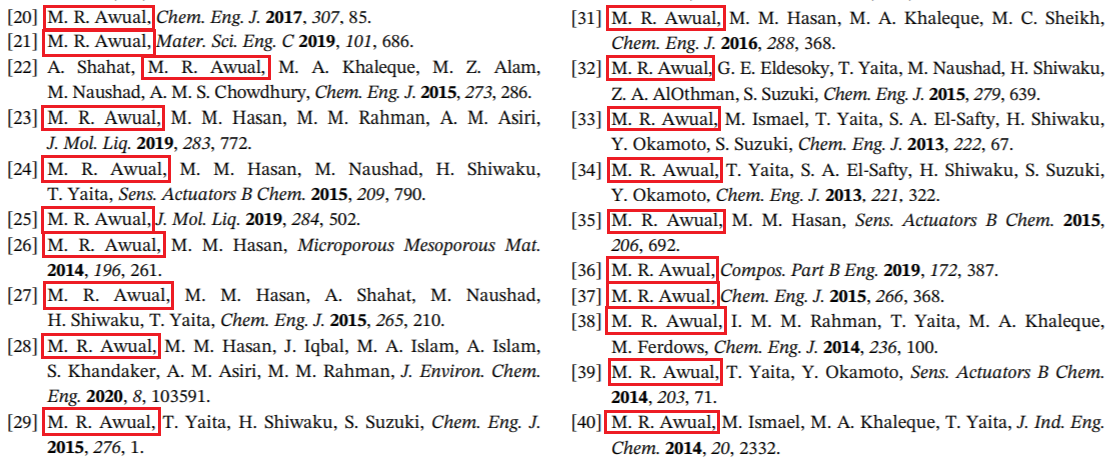

For some papers in this oeuvre, the nominal authors have not reviewed the field as thoroughly as one would like, and their References stagger under a lopsided burden of citations to a single author. One can only speculate about the identity of the Editor or the reviewer in these cases. But conversely, M.V. Simkin argued that if the studio simply picked a handful of ‘primary’ references at random (maybe from earlier cursory websearches as part of previous confections), and then delved into some of papers to randomly scrap ‘secondary’ references to populate the rest of their recycled bibliography, this would fit the observed distribution. It would also reflect what goes on in ‘legitimate’ academia. The implication is that no aspersions or accusations should be cast at the beneficiaries of citation donation.
This citation pattern is consistent with the model of random-citing scientists.
Zheng & Zhao
I allow myself a digression here to touch on the corpus of Zhiqin Zheng and Jun Zhao – fluorescence engineers, and regular recipients of the stressful regard of PubPeer contributors. I gave them their own “Zheng & Zhao” worksheet in the present spreadsheet.
The last sentences of their papers are what draw me to this pair; they smuggle in weighty cargoes of gift-wrapped citations, like a text-based Santa Claus. The citations are admirably eclectic, but also irrelevant to the topic of the paper, listed on the flimsy pretext that “these are also interesting subjects, on which our findings shed light and provide insights.”
“this work could also give some ideas to addressing the enviromental problems that are similar to Ce-doped SrBi4Ti4O15 ceramics [39], nano-Sb2O3 and brominated epoxy resin [40], and ZnSe nanostructures [41]. Typically, this work may provide an insight into combining with the theoretical and computing prediction methods (such as, the acoustic emission signal processing technology [42], tag identification algorithm [43,44], and ensemble data reduction techniques [45–48] to develop other types of environmental methods that are potentially used for separation of water/oil emulsion [49,50], dye wastewater treatment [51], photocatalytic hydrogen and production [52–54].”
RFID tags! Bug severity! Sound processing! Solar water heaters!
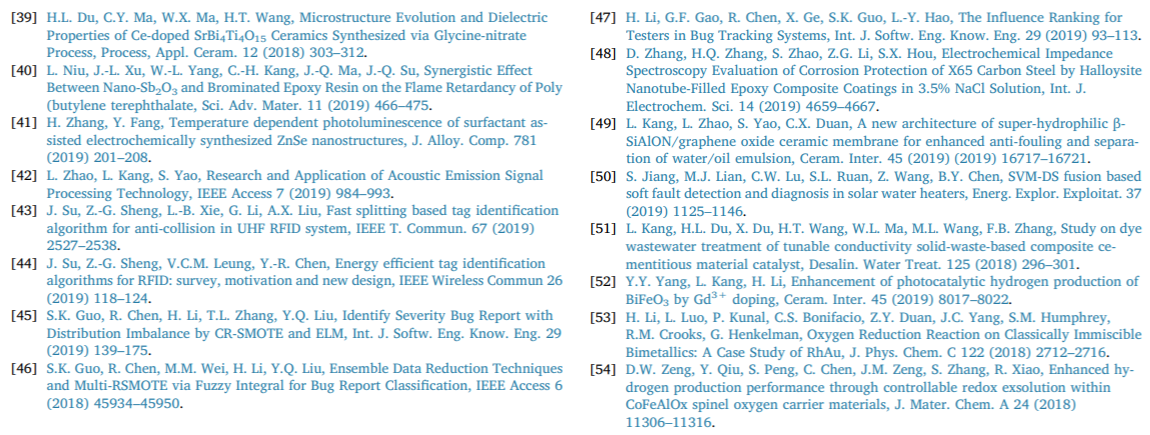
* * * SPOILER ALERT * * * No light was shed. No insights were provided.
These supercargos of superfluous citations overlap substantially from one of the group’s papers to the next. Moreover, the authors promoted in this corpus also overlap with the reference wallpaper from the larger papermill. But further inquiry is left as an exercise for the reader. Suffice to say that in one case at least, the concluding sentence and its concatenated citations were added at the Proof stage, and were not a feature of the pre-proof version that was accepted by the reviewers (and is helpfully archived at Sc*-H*b). It is natural to generalise to a suspicion that the other papers from this team also gained their payloads of citations after acceptance, perhaps with remuneration involved, and if I were editing the journals in question then Questions Would Be Asked. Perhaps even rhetorical ones.
With that digression out of the way, refresh your memory about the ’email identity’ style mentioned in my previous post. In preference to institutional email, corresponding authors like to open social-media email accounts for negotiating with journal editors, and a surprising number independently choose identities of the form “$name_$name66@***.com” (or 666 instead of 66), on account of those numbers’ auspicious connotations. It was almost as if the manuscripts were all written and submitted on behalf of the ostensible authors, by a papermill specialised company… not bothering to generate nyms in a plausible range of styles when opening the burner accounts, since after all they won’t be needed again.
Yes indeed, this “66” format also dominates the email addresses during early phases of the present papermill, consistent with my belief that “coordination-polymer” fabrications are just one of a broad range of services offered by the ‘science-adjacent’ papermill. But as well as updating their EndNotes file of high-rotation References, the millers have adopted alternative schemes for email identities, and we also see “$name_$name11@***.com” and “$name_$name22@***.com“. I am happy to recognise this improvement in tradecraft.
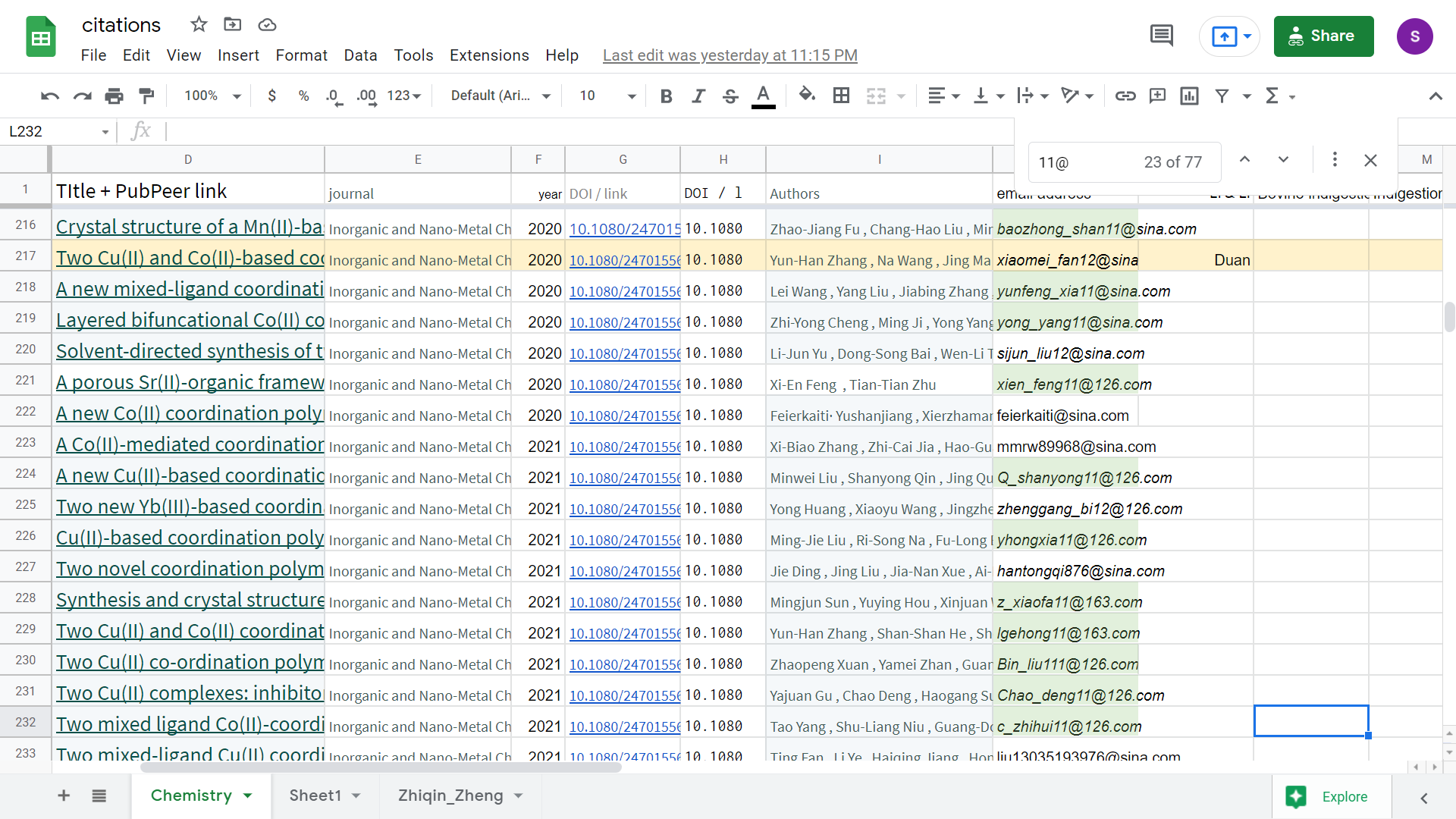
If these are burner accounts, mostly abandoned after a paper is accepted and the cheque has cleared, we shouldn’t expect many responses at Pubpeer to the invitations to join the discussions. But there are always exceptions. Y. Gao’s defense of “Two Cu(II) and Co(II) complexes: Magnetic properties and protective activity on burn disease by regulating the proliferation capability of mutated fibroblasts” was to ask for personal contact details…
I do not think it is a serious question, I do not know how to answer it, can you give me your E-mail?
J.-P. Liu insisted that the recycled SEM in Tian et al (2020) was “provided by center of forecasting and analysis“, and that the nonsensical citations were merely the ones suggested by a web-search.
The listed references are suggested by baidu scholar via using the keywords as the searching.
I haven’t yet found any papers from this mill about a coordination polymer that fluoresces in the presence of sarcasm AND cures vomiting in laboratory rats, but I’ll continue looking.
Endnotes (not even Frontiers spared….)
¹ Also in Journal of Ethnopharmacology, and Frontiers in Pharmacology. There, the co-composting with chickenshit morphed (along with “hydrogen peroxide presoaking prior to ammonia fiber expansion”) into a preliminary stage of processing herbs for use in Traditional Chinese Medicine. Those papers were written by TCM experts so I defer to their expertise.
There may be an element of citation coercion. In one case at least, the references to Zhao’s extensive work on corn-waste pre-processing are absent from the pre-print version that was accepted by reviewers, so they were shoe-horned in at the proof stage. But that is someone else’s problem.
² Later in Liu et al: “Briefly, the plasma of the rabbits was collected, and the fibrin for 2% rabbit blood preparation was removed.” Rabbits had not been previously mentioned. If this were a conjuring performance the unheralded appearance of rabbits out of hats could be expected, but I thought this was a scientific paper.
³ This is an example of a rhetorical question, which I invented. Not many people know that. I am too modest to make a big deal about it, which is why Rhetor gets all the credit.

Donate to Smut Clyde!
If you liked Smut Clyde’s work, you can leave here a small tip of 10 NZD (USD 7). Or several of small tips, just increase the amount as you like (2x=NZD 20; 5x=NZD 50). Your donation will go straight to Smut Clyde’s beer fund.
NZ$10.00

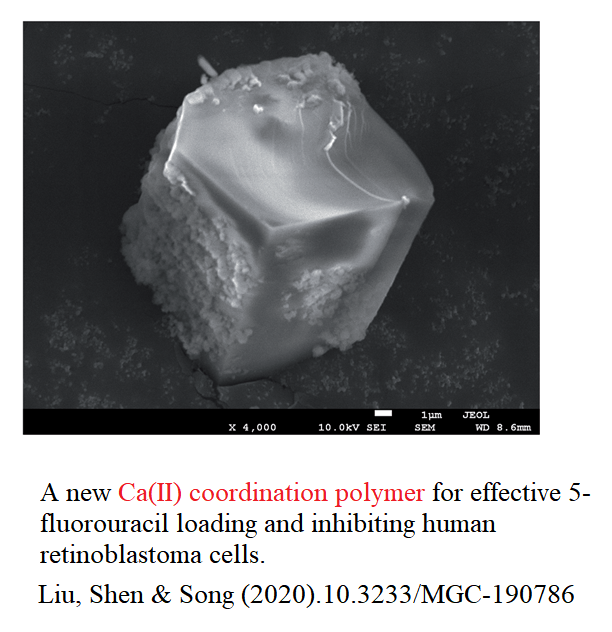
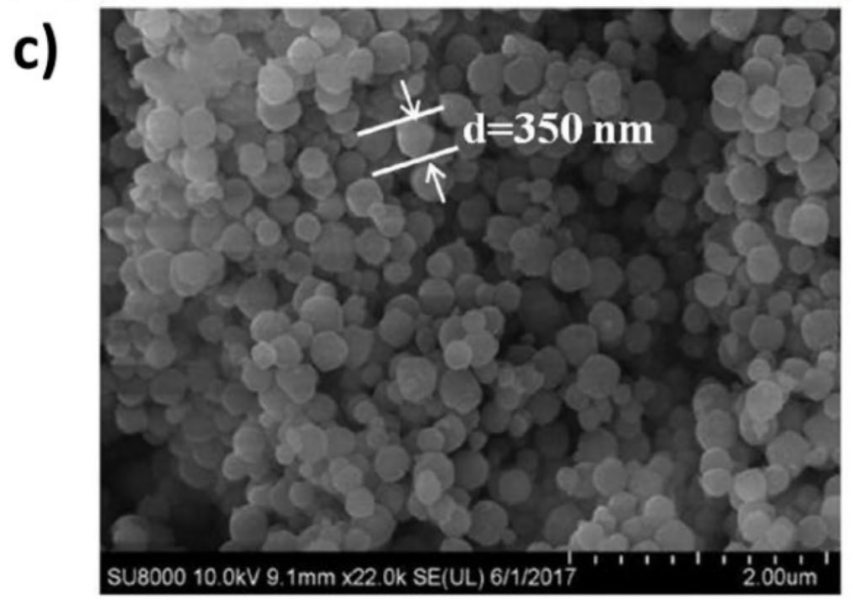

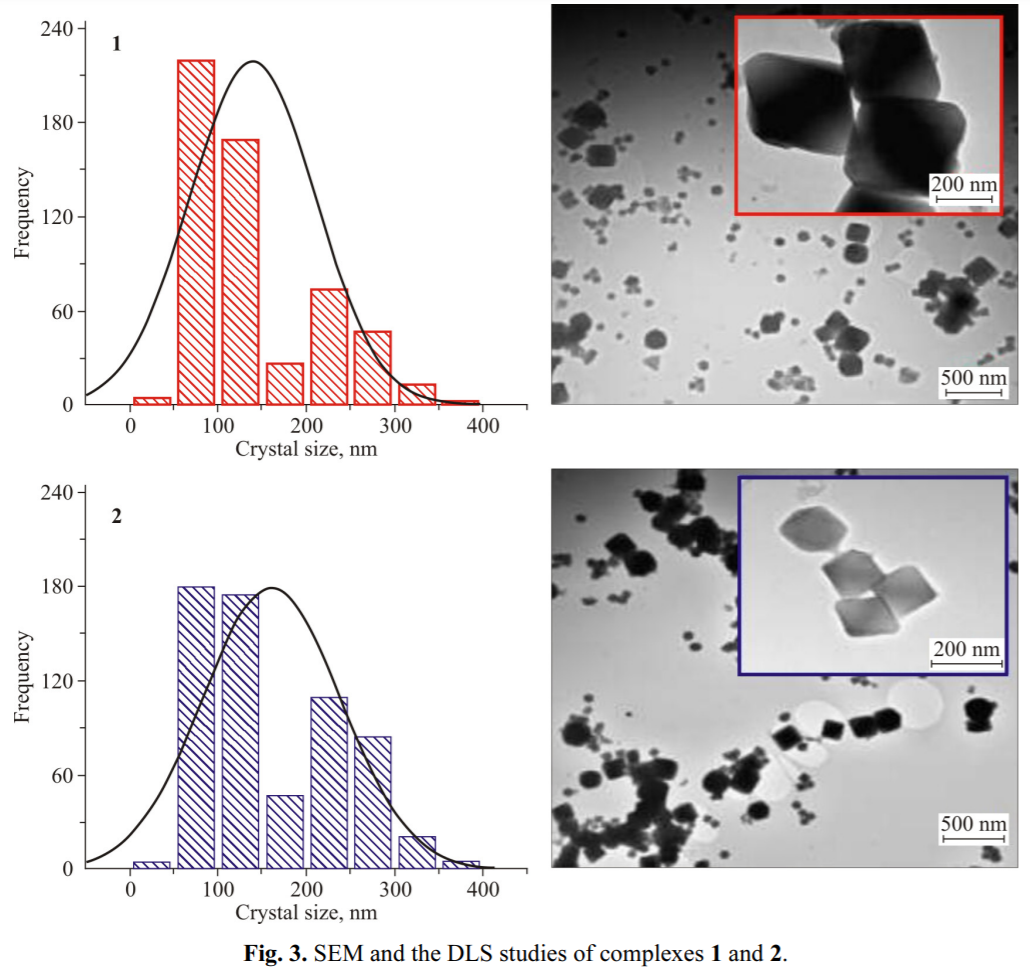
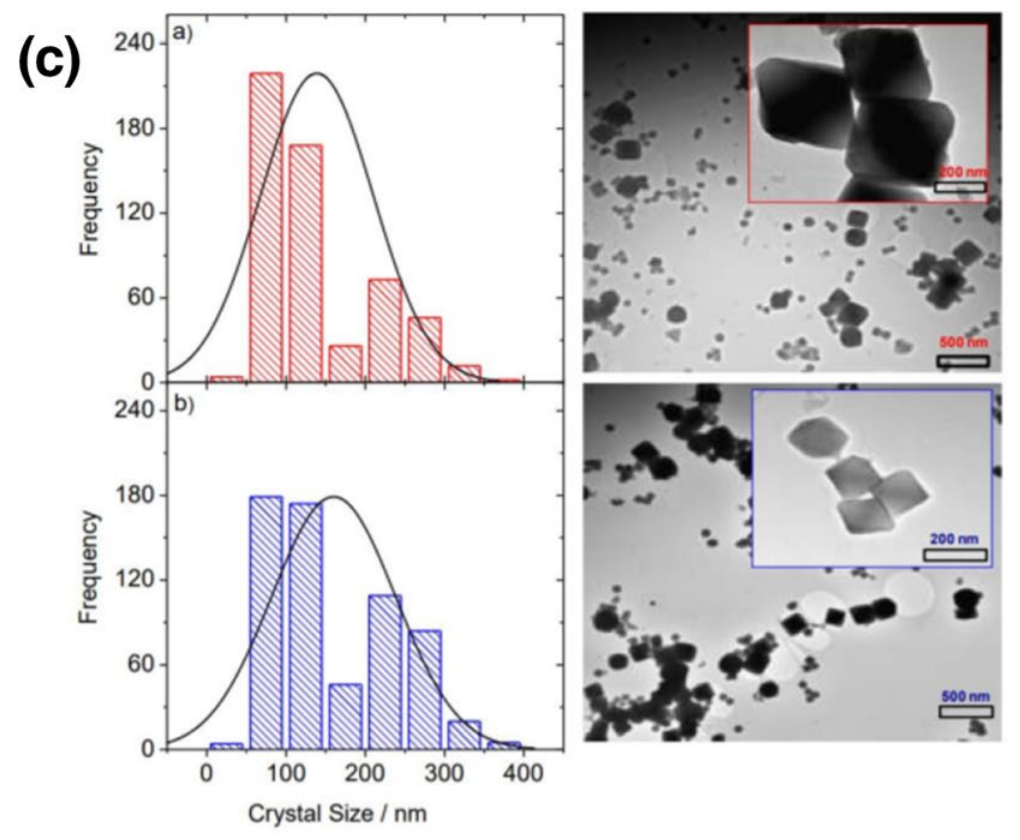
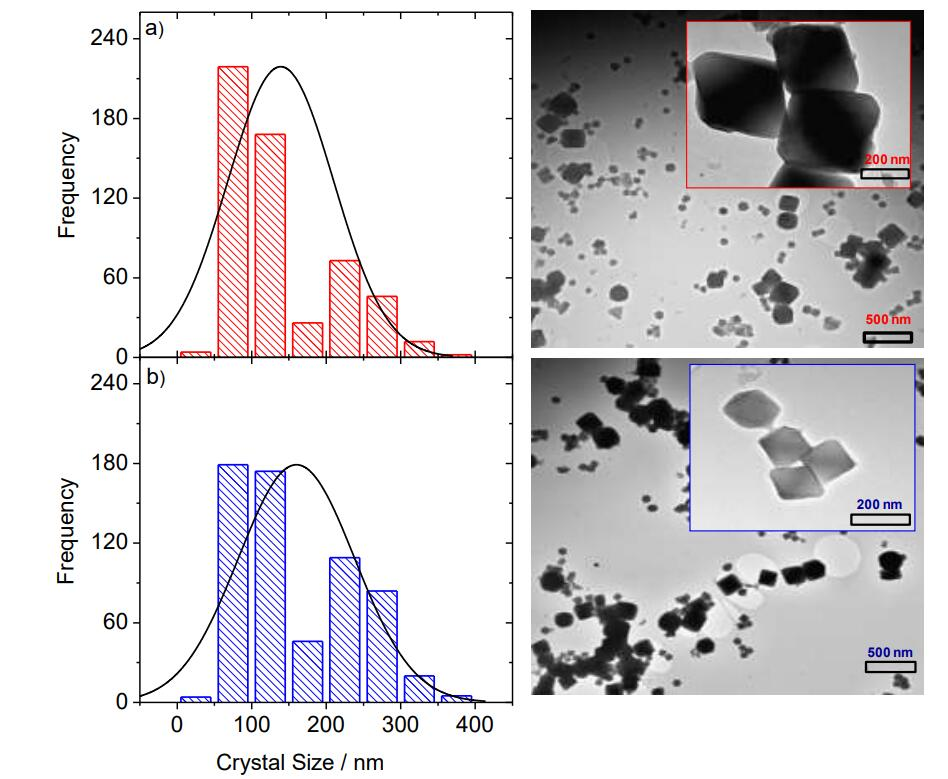

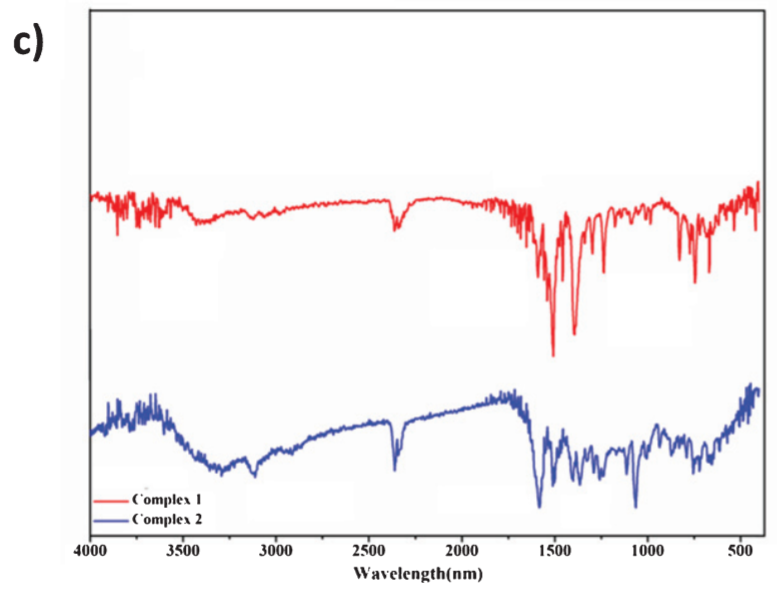

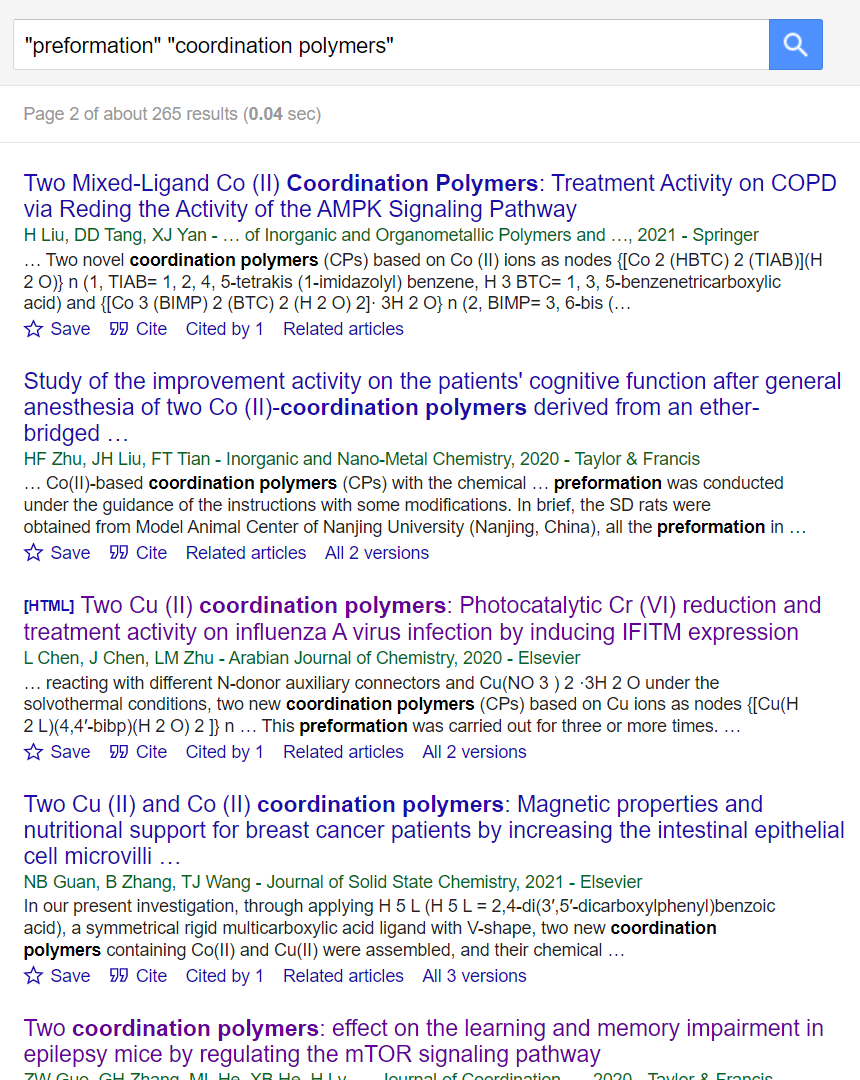


Pingback: Endemico ≠ benigno – ocasapiens
Do you think it’s handmade or they have software assisting them to assemble those fake papers? Realistically, that should be relatively easy, many tittles already sound computer generated.
LikeLike
I think Smut Clyde is doing important, pioneering work. Clearly an enormous amount of effort has gone into that disturbingly large spreadsheet and the accompanying pubpeer comments.
However, I don’t think blog posts alone do justice to that work. I would recommend writing a preprint, summarizing the results to date as simply as possible. A spreadsheet could be uploaded as supporting information, or separately to zenodo or figshare. Both sites allow updates, with each version archived. I suspect many people would be interested in using and building on the results, but would not be comfortable citing an editable document that could vanish at any time.
LikeLike
In any case, scientists and editors can try to reference Smut Clyde’s work on For Better Science, instead of the usual Byrne & Christopher, Nature and Science. As for doi permanence: did you hear of Frontiers deleting their own antivax and covidiocy papers, with their doi leading nowhere? True story.
LikeLike
Thanks for the flattering and tempting suggestion. I will run it up the flagpole and see who salutes.
LikeLike
Another author response! https://pubpeer.com/publications/459E6CCAC4532D6EA6D3930372DFAC#3
We learn that “The listed [absurd and recycled] references are cited according to the reviewers’ comments”.
Also, that “The SEM is collected by the testing company since there are no such instruments in our hospital. We will contract the tester to query about this issue and sent the new samples to other different testing company. If there are wrong results, we could make a correction to this manuscript.”
The author in this case is Lei Pan, affiliated to Department of Orthopedics, Affiliated Hospital of Inner Mongolia University for the Nationalities, Tongliao, Inner Mongolia. Lei Pan is one of the papermill’s more regular customers, having signed seven of its products. The other corresponding author was Yang Liu, another loyal customer and signatory of <nine products (most of them shared with Lei Pan).
It may be that there is something in the water at Tongliao, Inner Mongolia. Consider the academic contributions of Zhi-Fang Zhang (affiliated to Tongliao City Hospital, Tongliao): 14 papers flagged at Pubpeer, all from the present papermill.
Zhang was another co-author with Lei Pan and Yang Liu, on the paper where bogus citations had been included to satisfy the reviewers, and where the plagiarised SEM image was the fault of an unnamed outside contractor that had done the actual work. Zhang was also co-author of “A new 1D Zn(II) coordination polymer containing pyridinyl-imidazolyl ligand: crystal structure and protective effect on dermatitis by reducing the inflammatory level” — in which (according to corresponding author Ji-Ping Liu) “The SEM imagines are provided by center of forecasting and analysis. We will synthesize new samples and check this issue”; and “The listed references are suggested by baidu scholar via using the keywords as the searching”. It seems that despite the bogus email identities, someone in this group of loyal papermill customers has received the emails from Pubpeer, inviting them to join the discussion of their papers… or perhaps the papermill is responding on their behalf.
Another group at Affiliated Hospital of Inner Mongolia University for the Nationalities (Tongliao) is centred on Gui-Feng An, with eight fabricated papers. Some overlap with Zhi-Fang Zhang’s group (four papers in common).
LikeLike
Oops, I missed two more papers with replies from someone using the identity of a corresponding author:
“Two three-dimensional Er(III) and In(III) metal-organic compounds: synthesis, crystal structures and antitumor activity in human glioma cells” (Yan Jiang, Zhi-Fang Zhang , Qiu-Li Zhang , Jin-Suo Bao , Cheng-Hua Du, 2018)
“Novel coumarin derivatives: Synthesis, anti-breast cancer activity and docking study” (Hao Han , Zhi-Fang Zhang , Jun-Fei Zhang , Bin Zhang, 2019)
Both from Zhi-Fang Zhang’s group again, to the surprise of absolutely no-one.
LikeLike
Pingback: [Citation not needed] – For Better Science
Pingback: The Iranian Plants Paper Mill – Science Integrity Digest
Pingback: Russkiy Mir at Elsevier and MDPI – For Better Science